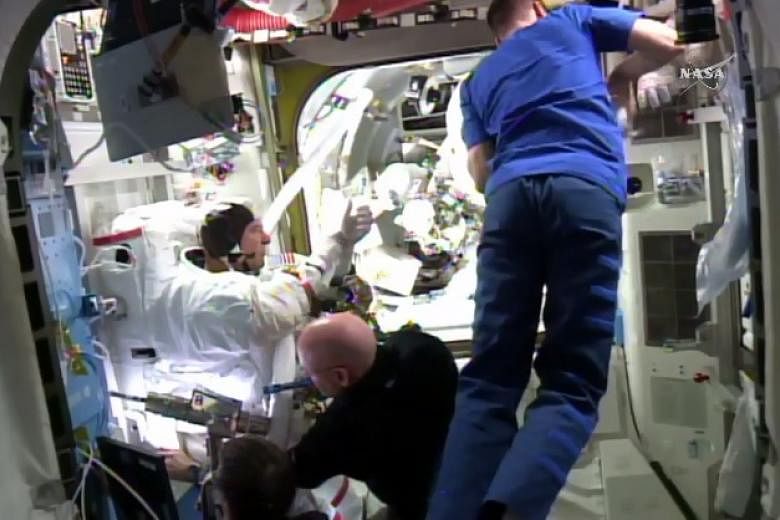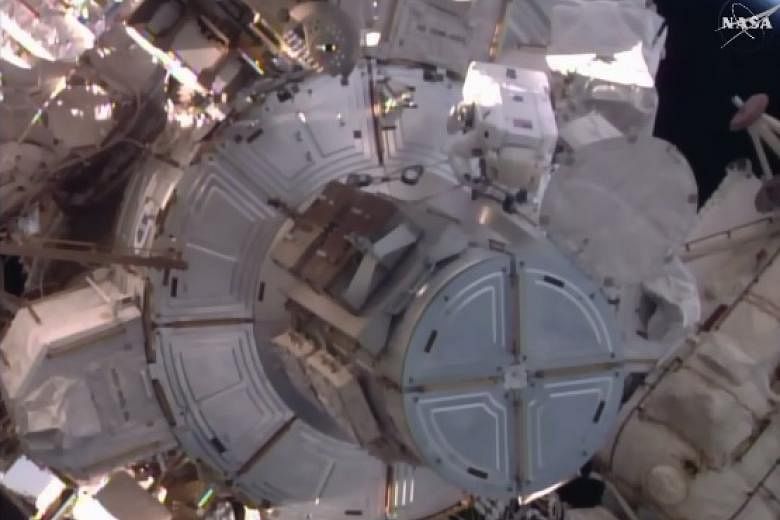MIAMI (AFP) - The discovery of water in a US astronaut's helmet brought an early end on Friday to the first-ever galactic walkabout by his British colleague, astronaut Tim Peake, Nasa said.
"A small water bubble" in American Tim Kopra's helmet led mission control to wrap up about two hours early out of an abundance of caution, Nasa commentator Rob Navias said.
"The crew is not in any danger whatsoever," he said.
However, the situation brought back memories of a harrowing incident in 2013 when Italian astronaut Luca Parmitano's helmet began rapidly filling with water and risked drowning him.
"This is nowhere near as severe as that incident was," said Navias, as he narrated Kopra's return to the airlock live on Nasa television.
Kopra had reported a high carbon dioxide reading in his spacesuit earlier in the outing, but felt no symptoms, and mission control decided the alarm was due to a faulty sensor.
The liquid showed up about four hours into the six-and-a-half-hour spacewalk.
Kopra said the wet spot was about 10cm long by 5cm.
Peake checked his colleague's appearance while they were outside the International Space Station and described what he saw as a "film of water."
Kopra said it was cold water, indicating the leak may have come from a cooling loop inside the suit, said Navias.
Shortly after flight director Royce Renfrew at mission control learned that Kopra was feeling dampness in his helmet, he decided to cut short the spacewalk.
By that time, the team's main mission - to replace the broken voltage regulator - had already been completed.
The spacewalk officially ended after four hours and 43 minutes.
The outing was historic for Peake, the first Briton to walk in space.
As Peake climbed out of the space station, American astronaut Scott Kelly positioned a camera from inside so that the British flag on the arm of Peake's spacesuit was visible to viewers watching live on Nasa television.
"Great to see the Union flag out there," said Kelly.
"It's great to be wearing it," answered Peake. "It's a privilege."
Peake's job was to haul a bulky component called a sequential shunt unit, contained in a white bag as big as a suitcase.
He carried the unit, which would weigh 90kg on Earth, to the far end of the space station's truss, about 60m from the exit.
Kopra, 52, making his third career spacewalk, toted the tools needed to remove the old unit and replace it with the new one.
The team's work was precisely timed to coincide with a nighttime pass of the space station to avoid sparks from any residual electrical current in the solar-powered equipment.
The ISS circles the Earth every 90 minutes, spending 31 of those minutes on each pass in the dark.
Peake said in a blog post Thursday he felt "exhilarated" about his upcoming spacewalk but had "no time to dwell on these emotions."
Following in the footsteps of Britain's Helen Sharman, who flew to the Russian Mir space station in 1991, Peake has drawn plenty of attention from his compatriots.
Among them was the Beatles legend Paul McCartney, who offered a message of "good luck" on Twitter.
"We're all watching, no pressure! Wishing you a happy stroll outdoors in the universe," McCartney wrote.



